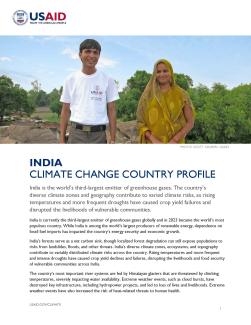India is the world’s third-largest emitter of greenhouse gases. The country’s diverse climate zones and geography contribute to varied climate risks, as rising temperatures and more frequent droughts have caused crop yield failures and disrupted the livelihoods of vulnerable communities.
India is currently the third-largest emitter of greenhouse gases globally and in 2023 became the world’s most populous country. While India is among the world’s largest producers of renewable energy, dependence on fossil fuel imports has impacted the country’s energy security and economic growth.
India’s forests serve as a net carbon sink, though localized forest degradation can still expose populations to risks from landslides, floods, and other threats. India’s diverse climate zones, ecosystems, and topography contribute to variably distributed climate risks across the country. Rising temperatures and more frequent and intense droughts have caused crop yield declines and failures, disrupting the livelihoods and food security of vulnerable communities across India.
The country’s most important river systems are fed by Himalayan glaciers that are threatened by climbing temperatures, severely impacting water availability. Extreme weather events, such as cloud bursts, have destroyed key infrastructure, including hydropower projects, and led to loss of lives and livelihoods. Extreme weather events have also increased the risk of heat-related threats to human health.
Government of India Climate Priorities
The Government of India has demonstrated a sustained commitment to combating climate change, as it promotes both climate mitigation and adaptation. Today, India is one of the fastest-growing countries in the world with respect to renewable energy generation and has the fourth-largest renewable energy generation capacity. Top goals under the country’s 2022 Nationally Determined Contribution to the Paris Agreement include:
- Enhancing the share of non-fossil fuels generation capacity to 50 percent by 2030;
- Reducing the emissions intensity of GDP by 45 percent over the 2005 baseline by 2030;
- Creating an additional carbon sink of 2.5 to 3 billion tons of CO2 equivalent through additional forest and tree cover by 2030;
- Investing in vulnerable sectors, such as agriculture and water, in key regions;
- Addressing resource gaps by mobilizing domestic and international resources to implement climate mitigation and adaptation actions; and
- Promoting a circular economy, citizen action, and resource conservation as espoused in “Lifestyle for Environment.”
USAID’s Climate Change Program: Objectives and Results
USAID supports the Government of India’s development and climate priorities through a series of programs and partnerships across climate adaptation, clean energy, natural climate solutions, and disaster risk reduction.
Adaptation
In partnership with the Government of India, the private sector, and national and international agriculture research organizations, USAID is implementing resilience-building activities with an increased focus on vulnerable communities in ecologically-sensitive, hazard-prone regions across India. USAID also partners with the Government of India to support the Coalition for Disaster Resilient Infrastructure (CDRI) to foster disaster- and climate-resilient infrastructure globally. Between 2022 and 2024, the United States and India served as co-chairs for CDRI’s Governing Council and Executive Committee.
Clean Energy
USAID is working with the Government of India to help achieve its goal of shifting the power sector to 50 percent non-fossil sources by 2030, and to meet its national target of 500 gigawatts of non-fossil energy capacity by 2030. USAID is also supporting the Government of India to achieve its targets of reducing the carbon intensity of the economy by 45 percent by 2030 (over 2005 levels) and reach net-zero emissions by 2070 through comprehensive energy-efficiency measures and strategies and advancing electric mobility in the country.
In partnership with the national and sub-national governments, USAID accelerates large-scale cross-border electricity trade, renewable energy deployment, grid flexibility for renewable energy integration, energy efficiency in buildings and appliances, utilities modernization, and electric mobility. USAID also supports the decarbonization of large corporations and helps the public sector to adopt renewable energy, energy-efficiency measures, and other advanced technologies. USAID partners with the Government of India to promote adoption of electric buses and vehicles and improves access to clean energy finance through innovative financing mechanisms and transactional advisory services.
Natural Climate Solutions
USAID partners with civil society organizations and the Government of India’s Ministry of Environment, Forest, and Climate Change (MOEFCC) to support India’s goal of creating an additional carbon sink of 2.5–3 billion tons of CO2 equivalent by 2030 through improved forest management, afforestation, forest restoration, and expansion of tree cover outside traditional forests. USAID programs strengthen forest and natural resource management through technological solutions for increased carbon sequestration, long-term water security, and improved livelihoods. USAID programs also support the development of market-based models for restoring degraded forest lands to improve ecosystem services.
Key Results
Forestry Results
USAID is partnering with MOEFCC and state-level forest departments to promote a more holistic ecosystem services approach to forest management—a departure from the Government of India’s traditional practice of managing forests solely for timber. Coupled with a new geospatial application developed by USAID, these efforts are improving forest and landscape management. In FY 2023, the new app and approach were used in forest divisions covering about 5 million hectares, and the Government of India has indicated an interest in scaling these efforts nationwide. USAID interventions to promote forest and landscape management during FY 2023 resulted in an estimated emissions reduction and sequestration of more than 2,626,000 tons of CO2 equivalent.
USAID has helped:
- Jointly develop technological tools with MOEFCC—such as decision-support tools for selecting appropriate tree species for planting, a traceability tool for tracing the source of timber, and a virtual marketplace for sale of non-timber forest products—which MOEFCC is working to deploy at scale
- Establish a successful model for women-owned enterprises involving natural resources such as banana fiber, bamboo, and certain tree leaves; so far, more than 30 enterprises have been established and have sold products worth $3 million in a span of four years, including sales to global retailers such as IKEA; these efforts have resulted in a 40 percent increase in income for 7,600 women producers
- Launch a first-of-its-kind pay-for-success mechanism/development impact bond in the forestry sector—based on the success of the aforementioned women-owned model—involving an end-to-end model for bamboo production and the creation of value-added products that will help leverage resources from both the public and private sectors (1 to 15 leverage ratio) and advance efforts to mitigate climate change
Clean Energy Results
Since 2016, USAID and the Government of India have mobilized more than $3.5 billion in public and private investments, installed more than 14,500 megawatts (MW) of clean energy—or enough to power more than 9.4 million households—and improved energy access for approximately 5 million people. This ongoing collaboration has also strengthened India’s renewable energy sector through a national energy-conservation code. USAID supports India’s on-grid integration of large-scale renewables and has helped deploy advanced energy efficiency technologies.
USAID has helped:
- Develop a national energy-conservation building code and increase the energy efficiency of more than 11,000 public buildings and 10,000 low-cost apartments
- Support India’s real-time market and National Open Access registry, an online platform for registering power market participants, which enables real-time market operations
- Launch the virtual Smart Grid Knowledge Center in cooperation with PowerGrid India to showcase new technologies and train energy-sector stakeholders from India and abroad
- Partner with the Government of India’s Ministry of Power under the $42 billion “Revamped Distribution Sector Scheme” to modernize power distribution utilities
- Support electric mobility by developing new investment platforms, designing an e-mobility charging site assessment tool, training technicians, delineating e-mobility strategies for Indian Railways, and promoting procurement of e-buses
- Promote new fuels and technologies such as green hydrogen through feasibility studies, capacity building, and standards and regulations in partnership with NTPC Renewable Energy Limited, Skills Council for Green Jobs, and the Government of India’s Ministry of New and Renewable Energy
- Support new policies for wind repowering in collaboration with the Government of India’s Ministry of New and Renewable Energy and the Government of Gujarat
- Develop new innovative tenders with Indian Railways to provide 1,650 MW of round-the-clock renewable energy and create an energy-efficiency action plan
- Increase South Asia regional cross-border electricity trade four-fold from 1,400 MW in 2012 to more than 5,270 MW in 2023
- Launch the world’s first emissions-trading scheme for fine particulate matter




